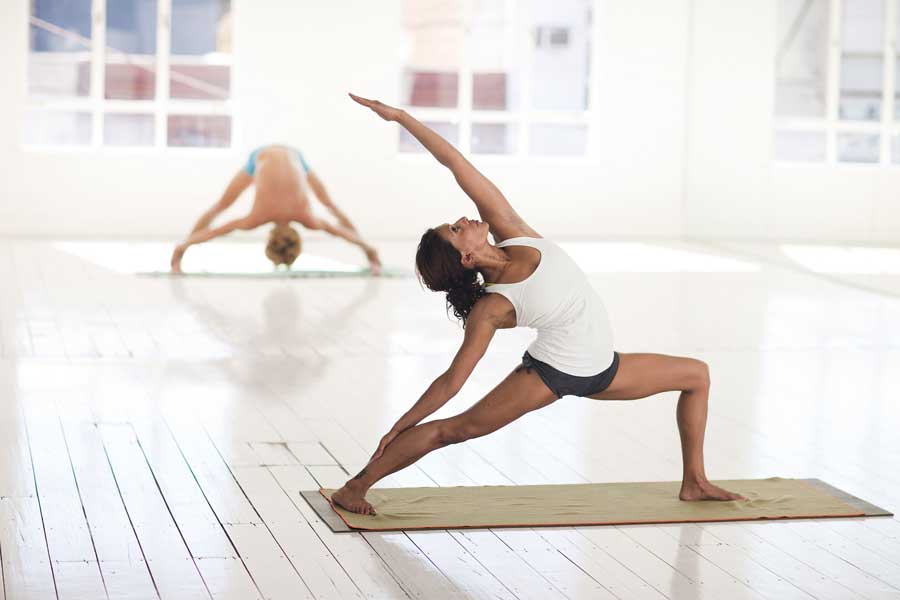Front splits are still front splits, even if you can’t flatten your legs to the ground.
By Carmen Curtis
Front Splits | Dispelling Some Myths
For many, Hanumanasana, or front splits, is an intimidating pose reserved only for the hyper-mobile.
Or, atleast, that’s what social media and the ego will have you believe. Front splits is still front splits, even if you can’t flatten your legs to the ground. Definitely not reserved strictly for the hyper-mobile. Splits actually can cause some damage for the super flexible if done incorrectly.
As an elite gymnast and Cirque performer, I had what appeared to be a full split.
Yet my alignment was completely off. To ensure that my splits were “good,” I would externally rotate my back leg and arch and twist my spine.
It was a great party trick that left me with 2 bulging discs in my mid-40s. I eventually came back to this pose as a yogi rather than a performer. Only then did I discover the damage I had inflicted on my body. I also learned the proper way to do Hanumanasana so that I could heal my body instead of hurting it.
You can do front splits too, even if you aren’t a super flexible person.

We often want to externally rotate that back leg so that our splits go deeper. Yet, what we are really doing is knocking our pelvis out of safe alignment and possibly injuring our low back. This is what we mean when we say the ego is running your practice. To begin, let go of any expectations of how the pose should look. Focus on how it feels in your body while maintaining proper alignment.
How to do Hanumanasana
First things first, don’t force yourself into the posture. To begin, break the pose down into different elements needed for the full expression. Warm up the hips, hamstrings, hip flexors, as well as learn how to maintain square hips with your legs apart. Some postures that might be helpful towards maintaining a neutral pelvis in splits are parsvottanasana (pyramid pose) and virabhadrasana III (warrior III). These poses allow the body to feel what a neutral pelvis (hips squared) feels like.
Watch those hips!
Alignment here is key. Try drawing the front hip back while simultaneously drawing the back hip forward, an isometric movement. Work to stack the torso vertically over the pelvis. Try not to arch the back here, although you might have a slight arch if you have tight hip flexors. When the back leg and hip are turned out it forces a rotation in the spine as the torso twists forward. This is a very common approach to get all the way down to the floor. Arching and twisting the spine when the hips aren’t square puts pressure on the discs. This creates the possibility for strain to the SI joint and lumbar spine. Working to keep your hips squared is essential. Internally rotating the back leg will help maintain a neutral position and assist in keeping your spine safe.

Let Go Of The Ego
It’s easy to fall into that idea of what we think a pose should look like. Or maybe wanting to achieve a deeper variation, for the sake of aesthetics. Maybe we have a strong side and an “adventure” side (i.e. the less flexible side) and tend to only do certain shapes on the “better” side. I completely understand that, as I used to only do full splits on my “good” side during a performance.
When I first started doing the splits during yoga I experienced a huge awakening to how off-balance I was. I was over-flexible on one side with the side effect of low back pain. I had to relearn how to stretch, how to do the posture, and what it felt like to have neutral hips and a neutral spine. Trying splits with the correct alignment felt foreign, and my ego initially took a hit. Keeping my hips squared meant I looked less flexible. What I discovered, though, was that yoga was offering me something more. More mobility, more strength, as well as relief from back pain. My goal now isn’t to get all the way down in splits (I actually don’t care if I ever do anymore). My goal is to do it correctly and safely.
If you have a “good” side, I challenge you to start practicing more on your less flexible side. Focus on balance, not show. This posture shines a spotlight on the imbalances in our body. Tunes you into what it needs physically, as well as how we choose to practice. Ahem.. our ego.
Don’t Force It
You never want to force this posture (or any posture). Going all the way down in splits with the hips misaligned is dangerous and isn’t serving you. If you need support under the hips and legs due to less flexibility, place a bolster under your leg. You can also add a blanket if a bolster isn’t enough. Using props helps to support the body as it comes down. Maybe you put a block under the front knee. Maybe you have two blocks at your side so you can support yourself with your hands and aid in keeping a neutral spine.
Hanumanasana doesn’t have to be the intimidating pose that many people make it out to be. With the power of perspective, a mindful warm-up, and proper alignment you can make it safe. Add in the support from props and you can start practicing this shape at whatever stage of the yoga journey you’re on. Check out our aerial yoga online class that helps you safely get into your splits.

Sign up for our online aerial yoga classes and check out our Hanumanasana Class that focuses on proper alignment and technique for getting into splits while using the hammock as a prop.
